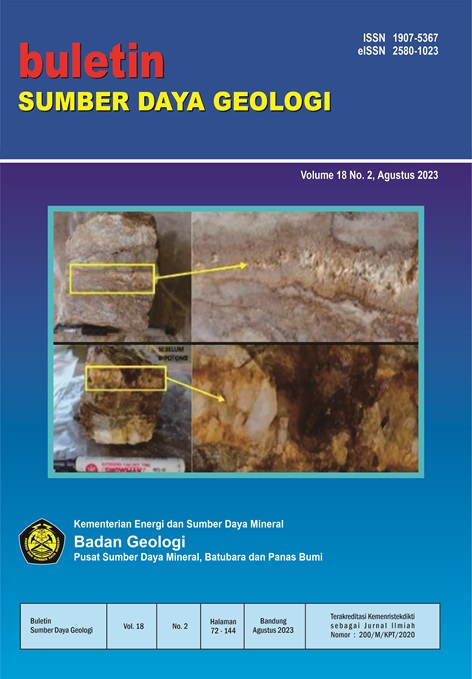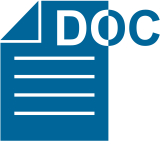ANALISIS SEBARAN LOGAM TANAH JARANG UNTUK PENGEMBANGAN WILAYAH PERTAMBANGAN MENGGUNAKAN CITRA LANDSAT-9 DI KABUPATEN BANGKA SELATAN
ANALYSIS OF RARE EARTH METAL DISTRIBUTION FOR MINING AREA DEVELOPMENT USING LANDSAT-9 IMAGES IN SOUTH BANGKA REGENCY
Abstract
The development of high technology currently relies heavily on rare earth elements (REE), some of which are obtained from tin ore mining. The largest production of tin ore is located in the Bangka Belitung Islands. To assess this potential further, this research aims to provide direction for development. The focus of this research centers on Monazite, which has the potential to be processed into rare earth elements, currently in high demand across various global industries and expected to see increasing demand. Monazite is a by-product of tin ore processing. Tin mining in Bangka Island, in general, and South Bangka Regency, in particular, has a long history dating back to the Dutch occupation period and continues to the present day. Geologically, the presence of Triassic-age granite is associated with tin formation, stretching from the Peninsula of Thailand-Malaysia-Riau Islands to Bangka-Belitung and West Kalimantan, known as the Granite Tin Belt. This is indicated by the presence of associated minerals such as Monazite, Xenotime, and zircon, which play a strategic role as REE sources. Regions abundant in mineral resources require proper regional planning to ensure optimal management and utilization. This study refers to the research results conducted by the Coal and Geothermal Mineral Resources Center (PSDMBP) in 2009, 2014, and 2018, which were compared with Landsat-9 images. The purpose of this research is to identify potential areas suitable for developing the Rare Earth Elements (REE) mining industry in South Bangka. The research methodology employs qualitative descriptive analysis and spatial analysis. The analysis results indicate the suitability of spatial utilization for mining activities in Rindik Village and Keposang Village, confirmed through on-site sampling to substantiate their potential. The presence of Monazite in over 50% of the total tailings samples suggests that the area can be developed into a Mining Business Area for REE commodities
Downloads
References
Azhar, M., Solechan, S., Saraswati, R., Suharso, P., Suhartoyo, S., Ispriyarso, B., 2018. The New Renewable Energy Consumption Policy of Rare Earth Metals to Build Indonesia’s National Energy Security. E3S Web Conf. 68, 03008. https://doi.org/10.1051/e3sconf/20186803008.
Bappeda, 2014. Rencana Tata Ruang Bangka Selatan tahun 2014 - 2034. Dinas Tata Ruang Bangka Selatan.
Dushyantha, N., Batapola, N., Ilankoon, I.M.S.K., Rohitha, S., Premasiri, R., Abeysinghe, B., Ratnayake, N., Dissanayake, K., 2020. The story of rare earth elements (REEs): Occurrences, global distribution, genesis, geology, mineralogy and global production. Ore Geology Reviews 122, 103521. https://doi.org/10.1016/j.oregeorev.2020.103521.
Goodenough, K. M., Wall, F., & Merriman, D. 2018. The Rare Earth Elements: Demand, Global Resources, and Challenges for Resourcing Future Generations. Natural Resources Research, 27(2), 201–216. https://doi.org/10.1007/s11053-017-9336-5.
Hamdan Z.A., Baharuddin & Surawardi in Metallogeni Sundaland Vol I (Ed.), 1999. Toboali Alluvial Tin Deposit: Geology, depositional processes, and material sources. Indonesia Mining Journal.1-12.
Irzon, R, Sendjadja, P, Kurnia, Imtihanah dan Soebandrio, J, 2014. Kandungan Rare Earth Elements Dalam Tailing Tambang Timah di Pulau Singkep, Jurnal Geologi dan Sumberdaya Mineral, Vol 15 No.3, Agustus 2014, Bandung, Pusat Survey Geologi.
Jordens, A., Cheng, Y.P., Waters, K.E., 2013. A review of the beneficiation of rare earth element bearing minerals. Miner. Eng. 41, 97–114. https://doi.org/10.1016/j.mineng.2012.10.017.
Mardiah, 2013. Karakteristik Endapan Timah Sekunder Daerah Kelayang dan Sekitarnya, Kabupaten Bangka Barat. Promine Vol. 1. No. 1 (2013).
Margono, U., Supandjono, R.J.B., dan Partoyo, E., 1995. Peta Geologi Lembar Bangka Selatan Skala 1: 250.000. P3G, Bandung.
Ngadenin, Fauzi, R., Widana, Widodo, 2014. Identifikasi Keterdapatan Mineral Ikutan dan Estimasi Kandungan Monasit Pada Tailing Tambang Timah Di Pulau Bangka. Buletin Sumber Daya Geologi Volume 17, No. 2, 2014: 97 – 108.
Peraturan Daerah Kabupaten Bangka Selatan Nomor 6 Tahun 2014 tentang Rencana Tata Ruang Wilayah Kabupaten Bangka Selatan Tahun 2014-2034.
Peraturan Pemerintah Republik Indonesia Nomor 23 Tahun 2010 tentang Kegiatan Pelaksanaan Usaha Pertambangan Mineral dan Batubara.
V. Popov, A. Koptyug, I. Radulov, F. Maccari, and G. Muller., 2018. Procedia Manuf. 21.
Pusat Sumber Daya Mineral Batubara dan Panas Bumi (PSDMBP), 2014. Kajian Potensi REE Dalam Tailing Timah Menggunakan Metode Remote Sensing, Badan Geologi KESDM, Bandung. (tidak dipublikasikan).
Pusat Sumber Daya Mineral Batubara dan Panas Bumi (PSDMBP), 2018. Potensi REE di Kabupaten Bangka Selatan Provinsi Kepulauan Bangka Belitung Kaitannya Dengan Endapan Timah, Badan Geologi KESDM, Bandung. (tidak dipublikasikan)
Pusat Sumber Daya Mineral Batubara dan Panas Bumi (PSDMBP), 2018. Indonesian Minerals Yearbook 2018, Badan Geologi KESDM, Bandung
Pusat Sumber Daya Mineral Batubara dan Panas Bumi (PSDMBP), 2019. Potensi Logam Tanah Jarang di Indonesia, Badan Geologi KESDM, Bandung.
Rahayu, & Candra, D. (2014). Koreksi Radiometrik Citra Landsat-8 Kanal Multispektral Menggunakan Top of Atmosphere (ToA) untuk Mendukung Klasifikasi Penutupan Lahan. In Seminar Nasional Penginderaan Jauh: Deteksi Parameter Geobiofisik dan Diseminasi Penginderaan Jauh (pp. 762–767).
Rohmadi, B.N., 2021. Analysis of Processing Rare Earth Elements from Monazite as Tin by Product Mineral. Jurnal Manajemen Bisnis Transportasi dan Logistik (JMBTL) Vol. 7 No. 2 Mei 2021. https://journal.itltrisakti.ac.id/index.php/jmbtl.
Szamałek, K.; Konopka, G.; Zglinicki, K.; Marciniak-Maliszewska, B. New potential source of rare earth elements. Miner. Resour. Manag. 2013, 29, 59–76.
Tampubolon, A., Rosana, M.F., Syafri, I., Yuningsih, E.Y., 2021, The occurrence of primary REE minerals and their paragenesis within S-type granite and quartz vein, South Bangka, Bangka Belitung Islands, Indonesia. https://www.researchsquare.com/article/rs-1849349/v1.
USGS. (2022). RARE EARTHS, Mineral Commodity Summaries. https://pubs.usgs.gov/periodicals/mcs2022/mcs2022-rare-earths.
Weng, Z., Jowitt, S.M., Mudd, G.M., Haque, N., 2015; A detailed assessment of global rare earth element resources: opportunities and challenges. Econ. Geol. 110, 1925–1952.
Undang-Undang Nomor 3 Tahun 2020 tentang Perubahan atas Undang-Undang 4 Tahun 2009 tentang Pertambangan Mineral dan Batubara.
Yudhatama, D., 2015. Identifikasi Bekas Lahan Tambang Timah Menggunakan Citra Satelit Penginderaan Jauh (Studi Kasus: Kabupaten Bangka Barat).
Zepf, V., 2013. Rare Earth Elements. Springer Theses. Springer Berlin Heidelberg, Berlin, Heidelberg. https://doi.org/10.1007/978-3-642-35458-8_2.
Zglinicki, K., Szamałek, K., Wołkowicz, S., 2021. Critical Minerals from Post-Processing Tailing. A Case Study from Bangka Island, Indonesia. Minerals 11, 352. https://doi.org/10.3390/min11040352.
Copyright (c) 2023 Buletin Sumber Daya Geologi

This work is licensed under a Creative Commons Attribution-NonCommercial-ShareAlike 4.0 International License.
Authors whose manuscripts are published agree to the following terms:
The publication rights of all journal manuscript materials published on the Buletin Sumber Daya Geologi website are held by the editorial board with the knowledge of the author (moral rights remain with the manuscript’s author).
The formal legal provisions for access to digital articles in this electronic journal are subject to the terms of the Creative Commons Attribution-ShareAlike (CC BY-SA) license. This means that Buletin Sumber Daya Geologi has the right to store, convert media/formats, manage in the form of a database, maintain, and publish the article without requesting permission from the author, as long as the author’s name is cited as the copyright holder.
Manuscripts published in both print and electronic formats are open access for educational, research, investigative, and library purposes. Beyond these purposes, the editorial board is not responsible for any violations of copyright law.















